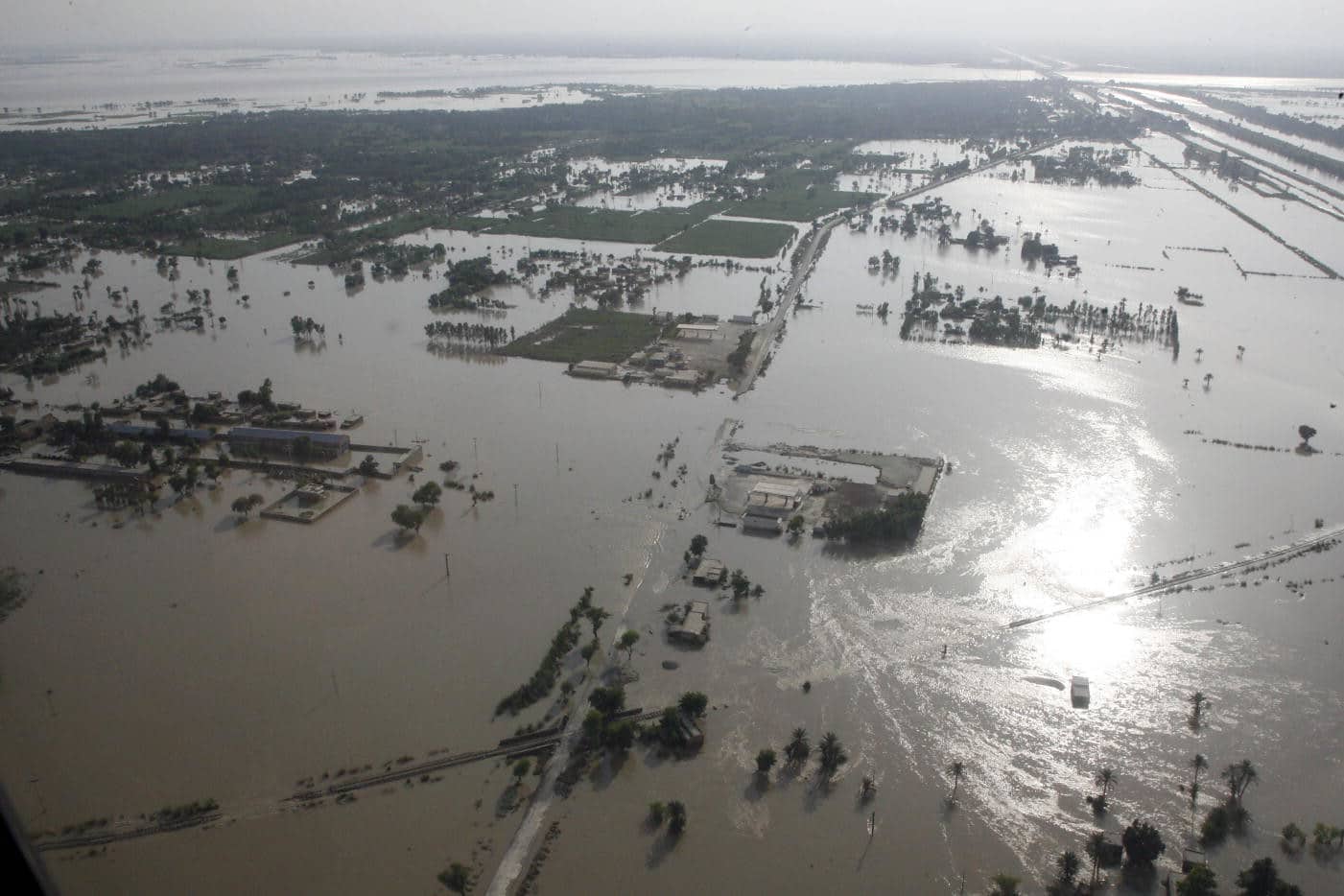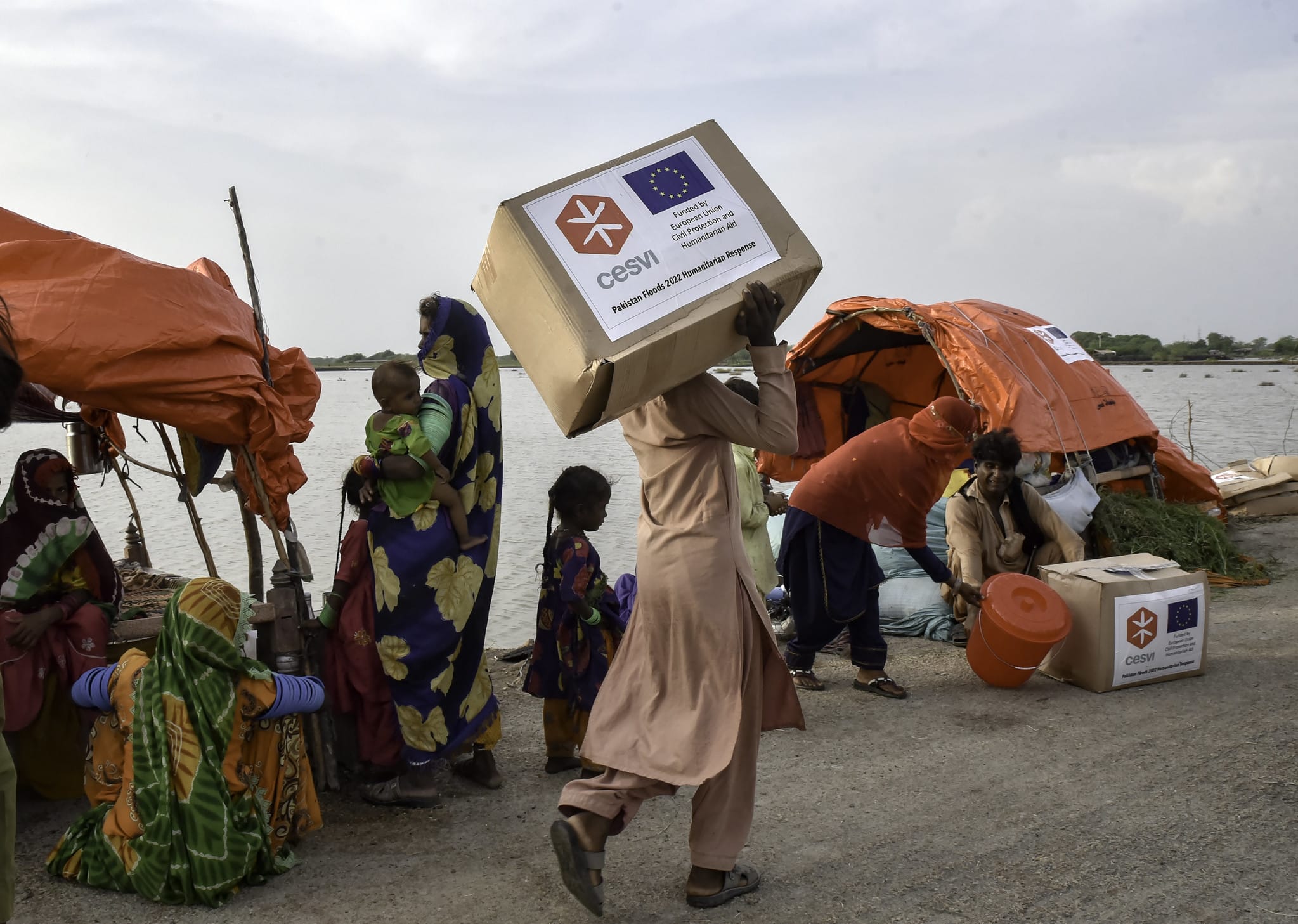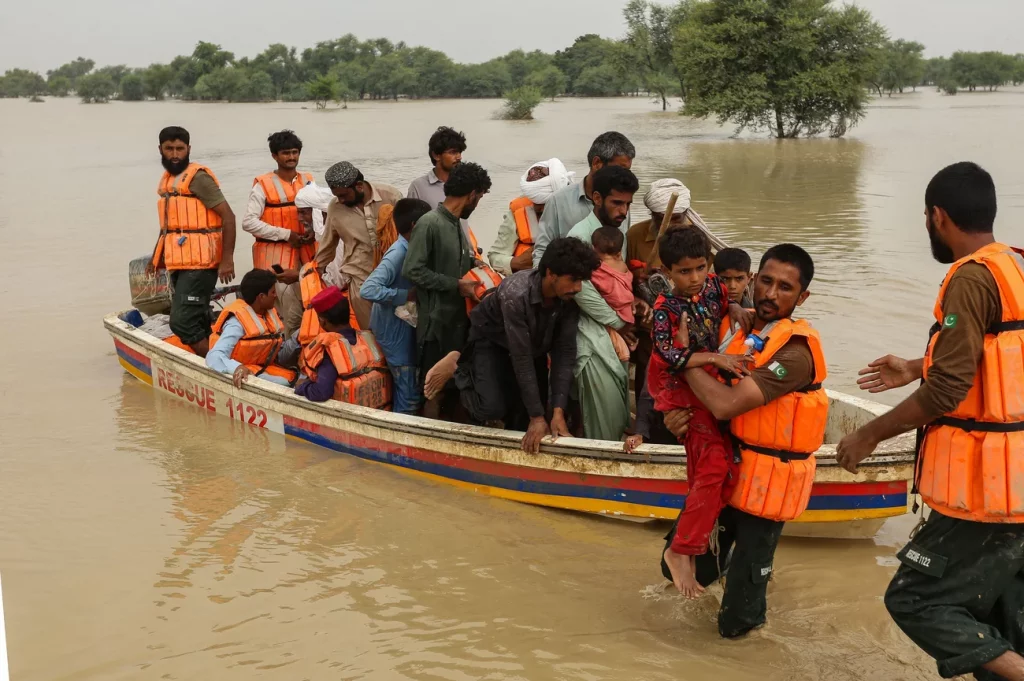The recent floods in Pakistan are by far the worst and most destructive the country has ever experienced. Current damage estimates are as high as US$28 billion. Nearly 1,700 people have lost their lives, two million acres of land are currently underwater, two million homes have been destroyed, and thousands upon thousands of kilometres of roads, bridges, and railways have been lost. As the flood-ravaged country desperately seeks aid from the international community, millions of Pakistani residents are either starving, dying, or both, leaving the rest of the world watching in disbelief as yet another calamity strikes this record-breaking year.
—
Pakistan, a country that contributes as little as 0.8% to global greenhouse gasses, is currently experiencing its worst and most destructive monsoon season yet, likely the result of climate change itself.
Described as biblical in proportion, the current Pakistan monsoon season has caused an incomprehensible amount of destruction, leaving over one-third of its land underwater and almost 1,700 people killed. The loss of two million homes, thousands of kilometres of roads, and hundreds of vital bridges mark the beginning of what will likely be an extremely difficult time for the 33 million displaced individuals who are still trying to survive, stay positive, and call Pakistan home.
During times such as these, information is an absolute necessity, and if you are looking to assist, you are probably wondering the same thing we are: What’s behind the catastrophic floods in Pakistan, what exactly is happening on the ground, and what can I do to help?
Food Insecurity Exacerbated by the Flooding
In a recent statement, the UN Office for the Coordination of Humanitarian Affairs made it abundantly clear that food insecurity – a problem that Pakistan was already facing prior to the flooding – will now be an issue of even greater concern for the nearly 5.7 million people (3.4 million of which are children) that live within the flood-affected areas of Pakistan.
Making matters worse, the little food that is available to these survivors is now being sold at absurdly high prices (the price of vegetables, for example, has tripled) in markets that are oftentimes too far to reach. This, in turn, requires that these desperate, fatigued, and hungry individuals wade through dangerous, unpredictable waters for hours on end just to feed themselves and their families.
In response to the destruction that has happened in Pakistan, Save the Children’s country director, Khuram Gondal stated: “The true devastation caused by these floods is becoming clearer every day. As well as dealing with the wreckage, the country is now facing a full-blown hunger crisis.”
Research by Save the Children has found that 86% of Pakistani families affected by the flood have lost their incomes completely and are unable to afford food. Some families are in such a state of desperation that they are encouraging their children to roam the streets and beg. Others are even willing to marry their children off in the hopes that they’ll survive with someone else. In a report by Save the Children, as many as 55 parents admitted to parting with their children and leaving them in the hands of somebody else just so they could survive.
You might also like: Why We Should Care About Global Food Security
The Destruction of Vital Agricultural Infrastructure
With 39% of the country’s workforce involved in agriculture, this year’s unprecedented monsoon season has been catastrophic to say the least. The record-breaking rains and floods that pummeled the Pakistan landscape left many farmers ill-prepared, and thus unable to preserve their crops.
Right before their eyes, their entire livelihoods – farms and other forms of agriculture that provide the food that makes up the backbone of the Pakistani diet – were completely swept away, leaving many of them desperately scouring the floodwaters for anything that they could save to survive the months ahead.

Photo by UN/Evan Schneider (Flickr).
Altaf Hussain Marri, a significant landholder in Khairpur stated in an interview that his 400 acres of cotton, rice, and wheat, worth over $40,000, had been completely destroyed in the floods, and that he is worried not just for himself, but for his entire country.
“If we fail to grow wheat, next year we might not have wheat to eat,” Marri said. “It will create food insecurity in the country. The poor will suffer a lot. There will be no flour.”
As troubling as this sounds, the government of Pakistan has stated that their disaster relief wheat stores are sufficient to last through the next harvest, and that they plan on purchasing more.
However, whether or not they’ll be able to achieve pre-flood production rates within a reasonable amount of time has yet to be determined. 50% of their second largest producer of wheat, the southern Sindh province of Pakistan, remains underwater, according to Jam Khan Shoro, a provincial irrigation minister in Sindh.
In an interview with The New York Times, a resident of rural Pakistan by the name of Padooma explained how vital these crops were to most farmers. “It is even more important than our children. We are living and we are dying for the wheat.”
You might also like: How Wheat Shortage Is Sparking a Global Food Crisis
Floods in Pakistan Are Spreading Diseases
According to Julien Harneis, UN Humanitarian Coordinator for Pakistan, the flood-stricken country is now entering its “second wave of death and destruction” as diseases like malaria, dengue, and diarrhoea are likely to proliferate, with children being the most vulnerable.
“There will be an increase in child morbidity and it will be pretty terrible unless we act rapidly to support the government in increasing the provision of health, nutrition and water and sanitation services across the affected areas,” said Harneis.
He has also stated that some of the main drivers of illness and disease after floods such as this are a lack of health facilities but, even more importantly, a lack of proper sanitation. Since many survivors are unable to access a proper toilet or other sanitary measures, many are forced to drink and bathe with the very same waters they defecate in. This can lead to all sorts of problems, namely e.coli infections, which in turn cause extreme fatigue, diarrhoea, and even death.
Since much of the water that has covered Pakistan is not moving, the standing waters have provided ample opportunity for mosquitoes to breed, and dominate the landscape. This has led to widespread infections of malaria, a devastating disease passed on through mosquito bites. According to data garnered from the Health Department of Balochistan, the worst-hit province, approximately 2,434 cases of malaria were reported within a single day in the Naseerabad division, prompting them to open as many as 1,621 medical camps to prevent its spread.
Is Climate Change to Blame for the Record-Breaking Floods in Pakistan?
Unfortunately, this isn’t the first time that Pakistan has experienced extreme weather events. During what would normally have been a cool March of this year, temperatures skyrocketed and were recorded as high as 40C.
The Global Climate Risk Index 2021 ranked Pakistan as one of the most susceptible to the effects of climate change. Despite the serious nature of this most recent flood, the disaster-prone country experiences destructive floods on an annual basis.
That being said, this year’s deluge has been called the most destructive Pakistan has seen in its entire history as a country.
“The Pakistani people are facing a monsoon on steroids — the relentless impact of epochal levels of rain and flooding” said UN Secretary-General António Guterres during his appeal for US$160 million (an amount that has increased fivefold, since then) in aid on August 30.
“Today it is Pakistan, tomorrow it could be your country.”
In an interview with Earth.org, Dr Asif Khan Khattak of the University of Peshawar, a professor who specialises in environmental sciences, says that climate change is the most likely culprit behind the sudden, extreme flooding that Pakistan has suffered.
“Pakistan experiences monsoon rainfall every year with some variation from year to year that has led to flooding in the past. However, this year the monsoon flooding has been unprecedented due to the record rainfall during the monsoon period in Sindh and Balochistan provinces. Moreover, the monsoon rainfall also saw a shift north-westwards resulting in excessive precipitation in the Khyber Pakhtunkhwa province. This led to flash floods.”
Dr. Khattak further states that climate change-induced heatwaves have had a disastrous effect on Northern Pakistan’s icy, mountainous regions, so much so that they became a significant contributor to the floodwaters that cover Pakistan today.
“Due to global warming there has been rapid melting of the glaciers in the Karakoram and Hindu Kush mountainous regions increasing the volume of water in the Indus river system. The glacial lake outburst floods (GLOF’s) also contributed to the flash flooding in the Khyber Pakhtunkhwa province causing extensive damage. Based on an attribution study recently by Freiderike Otto, it was shown that climate change likely contributed to the intensity and severity of the monsoon rainfall in Pakistan.”
It may come as a surprise to some, but the mountainous ranges of Northern Pakistan are home to over 7,000 glaciers, and is known as the world’s third pole. In some extraordinary situations (a heatwave, for example), major flooding can occur when these glaciers melt quickly. Referred to as GLOF’s the phenomena is characterised by the relatively quick buildup of melt-water lakes in the vicinity of glaciers, which eventually burst and cause destructive flash floods, much like what we are seeing today across most of Pakistan.
The phenomenon is especially prevalent in Pakistan. In fact, the Hunza district was recently hit by a GLOF in May of this year after a significant heatwave.
However, some experts do not believe this most recent deluge was a GLOF. “These floods were mostly the result of southbound rains,” said Dr Shafqat Munir, a research fellow at the Sustainable Development Policy Institute of Islamabad in an interview.
“To be very clear, the glaciers had nothing to do with the recent floods,”
Are There Any Solutions?
Though many believe that global warming is the sole reason Pakistan suffers such disastrous natural phenomena, the reality is that the country’s poorly prepared infrastructure further exacerbate the already catastrophic consequences of climate change-induced weather events that repeatedly hit the Asian nation.
Under the previous Imran Khan-led Pakistan Tehreek-e-Insaf government, most climate resilience efforts were centered on tree planting, clean energy, and electric vehicles. Although these are all commendable efforts, this was likely a serious mistake (aside from tree planting!), as issues like illegal construction, poor urban development, and a lack of proper water storage should have taken the forefront if they hoped to combat the disastrous natural phenomena that awaited them.
For example, urban development, like the building of large hotels and entire communities, was allowed to continue in areas where floods were known to cause the most damage. Illegal development in locations that were previously destroyed by floods, like the one that occurred 12 years ago, in July of 2010, went on undisturbed.
The Indus River System Authority (IRSA) reported that Pakistan receives approximately 145 million acre-feet (MAF) of water every year, but is only capable of storing 13.7 MAF. If they could store the floodwaters properly, not only would they prevent billions in damages and the loss of thousands of lives, they could also provide fresh water to their entire country.
However, this would require the Pakistani government to invest in dams, more specifically mega dams, that are capable of handling the increases in rainfall and glacier meltwater that are being seen every year. For example, the Diamer-Basha dam, should it be built in Gilgit-Baltistan, is expected to have an 892 feet-high spillway, 14 gates, and will be capable of holding 6.4 MAF alone. As life changing as its construction would be for the people of Pakistan, the associated cost is equivalent to nearly 10% of Pakistan’s total GDP.
That being said, there are other ways to prevent the damages caused by floods. The regular cleaning and maintenance of storm drains, the installation of rain management systems (water storage tanks), and the implementation of proper by-laws to prevent water diversion to city streets by large corporate chains and government buildings, would be a great place to start. Furthermore, being aware of water stock, and where storage tanks should be empty and ready for intense rainfalls, is also an area of focus that could use some improvement.

Photo by Abdul Majeed/European Union (Flickr).
How Can I Help?
Near the end of August this year, the United Nations issued an appeal for US$160 million in emergency funding for Pakistan, however this amount was found to be inadequate. As of October 5, the appeal has been increased five-fold – to $816 million.
“The United Nations Secretary General, Antonio Guterres, has already increased the relief funding for Pakistan.” says Dr. Khattak. “[However], Pakistan has been a victim of the impacts of climate change just like many of the other developing countries that have contributed very little to global greenhouse gas emissions. Developed countries that have caused the global climate change problem should ensure the provision of Loss and Damage Funding according to the Paris Agreement 2015 to those developing countries which are suffering due to the severe impacts of climate change.”
“Pakistan’s debt burden is very high, and the IMF and World Bank should provide relief.”
Dr. Khattak further states that although the Pakistan military, the National Disaster Management Authority (NDMA), and the Provincial Disaster Management Authorities (PDMA) have been providing assistance in all four provinces of the country, they could certainly use some help from the international community. “There is a need to enhance the operational capacity of these organisations.”
As you can see, help is needed urgently. If you’d like to donate, the UN Refugee agency, otherwise known as the UNHCR, is actively accepting donations. As are many other disaster relief efforts, including Save the Children, UNICEF, and Global Giving.
The UN is also asking for in-person volunteer support, with more ways than one to help out.
Featured image by Shahid Saeed Mirza/AFP via Getty Images
You might also like: Climate Change: Flooding Will Hit Asia the Hardest – Report


















